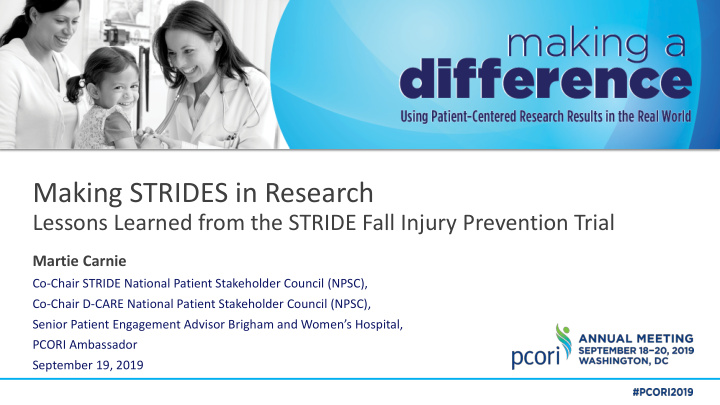



Making STRIDES in Research Lessons Learned from the STRIDE Fall Injury Prevention Trial Martie Carnie Co-Chair STRIDE National Patient Stakeholder Council (NPSC), Co-Chair D-CARE National Patient Stakeholder Council (NPSC), Senior Patient Engagement Advisor Brigham and Women’s Hospital, PCORI Ambassador September 19, 2019
Strategies to Reduce Injuries and Develop Confidence in Elders (STRIDE) Study • STRIDE is an important nation-wide effort to learn more about how injuries from falls might be prevented. • Randomized controlled trial (RCT) conducted in 10 health systems and 86 primary care practices around the U.S. • Over 5,400 participants aged 70 and older • A nurse Falls Care Manager performs fall risk assessments and develops individualized care plans • Results expected April 2020. 2
STRIDE Patient Engagement Model Bi-directional participation 3
Changing the Culture – Getting Researchers to Understand the Patient Voice • Face-to-Face meetings - getting to know you • Learning to work together • STRIDE Logo • Recruitment methods and materials • Consent form • Identifying community resources • Retention 4
Health Literacy Lessons Message to researchers: • You tell us what’s necessary to meet study design, IRB (Institutional Review Board) and other regulatory requirements. We’ll tell you how to make it clear and meaningful for study participants. 5
Health Literacy Lessons • Importance of systematic process to ensure all patient-facing materials are reviewed and approved by patient stakeholders • Written materials: • Letters *use of STRIDE logo on envelopes • Postcards • Brochures • Calendars • Newsletters 6
Health Literacy Lessons • Phone communications: • Phone scripts • For regular 4-monthly phone calls from the Recruitment & Assessment Center to participants throughout their enrollment *use of local phone number 7
Patient Engagement on All Key Committees 8
Securing the Bond • The patient voice was heard on all key committees to ensure bi- directional communication throughout the study. • In-person visit by patient engagement leaders to the Recruiting & Assessment Center/Data Coordinating Center (at Yale University) strengthened the patient voice in STRIDE. • Including patient perspective resulted in more effective patient- facing study materials and study procedures. 9
n is a number. n with a narrative is a compelling story. • “This is a good study and it’s made me more aware of my surroundings and of potential fall hazards.” • “I am exercising!” • “I learned information that I did not know pertaining to balance. It has been very helpful.” • “It made me more aware how to live without fear and enjoy the later years in life." 10
STRIDE Model adopted by PCORI Dementia Study (D- CARE) • Currently being implemented in the PCORI-funded study: Comparative Effectiveness of Health System-Based Versus Community-Based Dementia Care/ A Pragmatic Trial of the Effectiveness and Cost-Effectiveness of Dementia Care (PI: David B. Reuben, MD) • STRIDE patient engagement model can be adapted for any size trial. 11
Learn More • www.pcori.org • Publications: • info@pcori.org • Fagan, MB, Morrison CR, Wong C, Carnie MB, Gabbai-Saldate P. Implementing a pragmatic framework for authentic patient-researcher • #PCORI2019 partnerships in clinical research. J Comp Eff Res. 2016 May;5(3):297-308. • Stride-Study • Fagan MB, Wong C, Morrison CRC, Lewis-O’Connor A, Carnie MB. Patients, persistence, and • D-CARE Study partnership: creating and sustaining patient and family advisory councils in a hospital setting. J Clin • Institute for Patient-and-Family-Centered Care Outcomes Manag . May 2016; 23(5):219-225. • Health Literacy Annual Research Conference 12
Questions? 13
Thank You! Martie Carnie Co-Chair STRIDE National Patient Stakeholder Council (NPSC), Co-Chair D-CARE National Patient Stakeholder Council (NPSC), Senior Patient Engagement Advisor Brigham and Women’s Hospital, PCORI Ambassador martiecarnie@hotmail.com (617) 821-1144 September 19, 2019 14
Recommend
More recommend